- ホーム
- > 洋書
- > イタリア書
- > Arts & recreation
基本説明
Catalog of an exhibition held at the Galleria Borghese, Rome, Italy, October 25, 2022-January 29, 2023.
Full Description
"This exhibition and its substantial catalogue, comprising ten essays in addition to the entries for the works on display, represent an almost heroic attempt to embrace this multifaceted topic in its rich complexity." — The Burlington Magazine
During the 16th and 17th century, the discussion on the durability of artworks had become part of the debate on comparison of the arts, opposing the merits of sculpture to those of painting. The sculptors used coloured marbles and painters paint on stone (slate, lapis lazuli, paesina stone, etc.), while metals and precious woods contribute to the creation of extraordinary objects, such as small altars, cabinets, and clocks, with complex architectural shapes and adorned with sculptures, reliefs and paintings. Painting on stone was particularly popular in Rome: the technique, developed by Sebastiano del Piombo, was used to paint large altarpieces but also for smaller works, avidly collected by contemporary patrons, among whom Scipione Borghese stands out. The painting exploited the natural features of the stones for backgrounds, buildings, skies and the result were amazing objects appreciated for their preciousness.
Contents
1) Questioning the Stone.
2) Challenging Time, Sculpture, and Nature.
3) Sebastiano del Piombo, the Invention of Stone Painting, and Its Legacy in Rome. 4)Dark versus Light: Contrasting Approaches to the Use of Stone Supports in Verona and Antwerp.
5) From the Quarry to the Studio.
6) Fragments of Eternity: Painting on Stone in Seventeenth-Century Rome.
7) Rarities in Stone: Aesthetics and Mobility between Rome, Florence, and the Global World. 8) A Spanish Patron of Sigismondo Laire: Don Ruy Gómez de Silva, Third Duke of Pastrana. 9)"Petrae Volant, Scripta Manent": Traces of Stones in the Borghese Collection.
10) Two-Sided Paintings on Lapis Lazuli and Bluish Jaspers: Tempesta's Works for the Borghese Family and Others. I. The Collection and Colored Stones
II. Painting on Stone and its Creator.
III. Immortalizing Beauty.
IV. A Devotion as Eternal as Marble.
V. A Night as Dark as Stone.
VI. Painting with Stone.
VII. Allegory and the Antique.
VIII. Precious and Colored Stones








